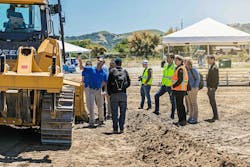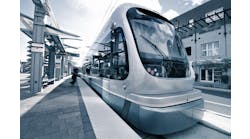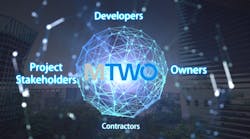Opportunity awaits at Calif. tech summit - WEB EXCLUSIVE
By: Larry Trojak
The state of this country’s infrastructure is truly something of a paradox. Its desperate need for upgrade is one of the few things that members of both major political parties can agree upon. It is an issue that affects literally every U.S. citizen, and yet action on it seems to be repeatedly sidetracked, treated as some sort of non-essential item that can be continually kicked down the legislative road. Members of the construction and peripheral support industries who have traditionally played a key role in infrastructure updates, recognize that action is inevitable and they are anticipating the nation’s soon-to-be massive needs with innovative solutions. A discussion of the state of infrastructure today—and the opportunities it holds for those involved in it—coupled with a look at many of those solutions, were at the core of a well-attended California Infrastructure and Technology Summit held on May 9, at Topcon Positioning Systems’ testing center in Pleasanton, Calif.
Even to the uninitiated, the need for infrastructure repair is obvious—any time spent on an area road or highway is testimony to that. However, the severity of the situation has been, in a sense, quantified for us by the American Society of Civil Engineers (ASCE), which says U.S. infrastructure scored a D+ on its last two “report cards” from the organization. With that dismal news as a background, Ray O’Connor, Topcon’s president and CEO, delivered opening remarks underscoring the gains made relative to infrastructure work and the tremendous opportunities available to those willing to face those challenges head-on.
“The U.S. is currently ranked number one in size of economy, in global currency and in agricultural production,” he said. “Yet, we are ranked number 10 in quality of overall infrastructure. The foundation of business is getting people to and from work and getting goods to market; that can’t be done with a crumbling infrastructure.”
O’Connor cited a Standard and Poor’s analysis from 2014 stating that globally there is $60 trillion worth of demand for infrastructure work, but only $24 trillion worth of ability to do that work. “That’s a $36 trillion deficit that can be greatly resolved by working smarter, and companies . . . are already helping make that happen,” he said. “Through an effort we call ‘The Intersection of Infrastructure and Technology’ we are striving to provide industry professionals with the expertise needed to increase productivity and profitability and, in turn, meet these growing infrastructure needs.”
O’Connor’s opening remarks were followed by a panel of industry experts convened to discuss ways in which their respective organizations were addressing the infrastructure issue. Moderating the panel was Iris Tommelein, professor of engineering and project management in the Civil and Environmental Engineering Department at University of California at Berkeley and an expert in the area of Lean Construction. She shared O’Connor’s confidence that industry is, indeed, poised to meet infrastructure’s daunting needs.
“We find ourselves in a very fortunate situation, in that technology is advancing at an incredibly rapid pace,” said Tommelein. “Our job is to leverage what is available today and plan for the best way to use what’s coming tomorrow. The panel we have with us today will share their thoughts as it pertains to those areas.”
The experts assembled for the Summit included: Kate Fox Wood, director of infrastructure policy for the Association of Equipment Manufacturers (AEM), who discussed the direction of infrastructure policy at the federal government level and AEM’s Infrastructure Vision 2050 initiative; Cindy Ng, director of UAV marketing for Intel, on the contribution of drone market technology to agriculture and construction; Kristen Sylva, construction industry marketing manager for Autodesk, who discussed the company’s Forge cross-platform integration system and the ways in which it can benefit construction professionals today; and Brock Grunt, executive VP of operations for McGuire & Hester, on building challenges such as the severe pressure on highway construction in California. The discussion was followed by a Q&A segment with session attendees, which included civic leaders and industry professionals as well as media representatives.
In addition to being a precursor to National Infrastructure Week held May 14-21, the California Infrastructure and Technology Summit was held in conjunction with the Livermore stop on the Topcon Technology Roadshow. The Roadshow, which will make 28 separate stops throughout North America in 2018, brings the latest advances in technology and software to professionals in the construction and geospatial industries.
While a 53-ft trailer, which expands to offer a fully-equipped showroom and presentation theater, serves as the focal point to showcase the technology, Roadshow attendees also had a hands-on opportunity to see just what the solutions offered via a fully automated fleet of excavators, dozers, motor graders and more.
“This is always one of the most popular segments of any Roadshow,” said Scott Langbein, Topcon’s director of marketing. “The ability to actually get in the seat and see how user-friendly and impactful these solutions can be is invaluable, and—as is almost always the case—feedback from the contractors was very positive. However, it was great to also see some of the media members climb into the cabs and run the equipment. Helping them gain a better understanding of the technology ultimately benefits everyone concerned.”
The technologies discussed at the Summit and on display at the Technology Roadshow underscore the impressive gains that have been made in the effort to streamline the workflow of today’s infrastructure projects. According to O’Connor: “There have been amazing developments in technology that are allowing contractors to do things that weren’t possible even five or 10 years ago. By continuing to develop, advance and implement our various technologies, we can shrink the gap associated with current infrastructure needs.”
O’Connor’s belief is borne out by a recent study from global management consulting firm McKinsey & Co., which says that the adoption of technology is upending estimates [of] infrastructure investment needs and is closing the infrastructure spending gap to between $12 and $20 trillion by 2030.
“So there’s already major progress being made,” said O’Connor. “Now the major hurdle is getting government—whether at the local or federal level—to invest in infrastructure projects. Governments that invest in their infrastructure grow their economies. We see that in counties such as Japan and Germany which are mandating that public projects use various types of advanced technologies to aid their productivity and efficiency.”
While no such mandates exist in the U.S., O’Connor added that contractors are nevertheless using these products because they know the benefits they offer. “They’re doing it because it drives their costs down and improves profitability. But having the government [mandate] will just ensure that everyone is getting the benefit of the technology.



